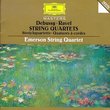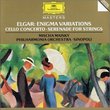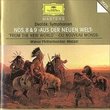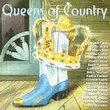| All Artists: Alfred Schnittke, Heinrich Schiff, Gidon Kremer, Chamber Orchestra of Europe, Yuri Smirnov Title: Kremer Plays Schnittke Members Wishing: 2 Total Copies: 0 Label: Dg Imports Original Release Date: 1/1/1994 Re-Release Date: 8/22/1994 Album Type: Import Genre: Classical Styles: Chamber Music, Forms & Genres, Concertos, Instruments, Strings Number of Discs: 1 SwapaCD Credits: 1 UPC: 028944552027 |
Search - Alfred Schnittke, Heinrich Schiff, Gidon Kremer :: Kremer Plays Schnittke
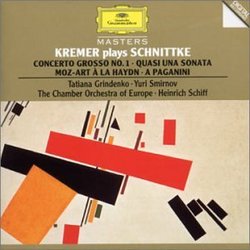 | Alfred Schnittke, Heinrich Schiff, Gidon Kremer Kremer Plays Schnittke Genre: Classical
|
Larger Image |
CD DetailsSimilar CDs |
CD ReviewsI REQUIRE YOU TO LOVE THE MUSIC OF SCHNITTKE AS MUCH AS I DO Daniel Johnson | 07/15/2001 (5 out of 5 stars) "If you're acquainted with Schnittke's string quartets or viola concerto, you might know what to expect from a disc like this one. When he was at his best - as he was, I feel, with the quartets and that concerto - he was darned close. And so he is, here - darned near perfect, for all of 75 minutes' worth of music. The Concerto Grosso No. 1 is performed persuasively and enjoyably, which must be quite difficult with a piece of music this eclectic both in style and emotional tenor. It veers - sometimes comically, sometimes almost frighteningly - between 18th-century decorousness, bawdy cabaret and abject expressionism. (Listening to it right now, I just spotted a quotation from Tchaikovsky hidden amidst a swarm of angry, screeching violins.) The switches that performer Yuri Smirnov is here required to make between the harpsichord and prepared piano are especially powerful - chilling, even. "Quasi una Sonata," an earlier work - appearing here in the composer's arrangement for violinist with chamber orchestra - is a little less shocking, but no less passionate and rigorous, and thoroughly compelling in its own right. The contrasts between thorny expressionism and tonal melody/harmony are perfectly calculated, very exciting. "Moz-Art a la Haydn," a "game with music," is a hoot. As the name might imply, basically tosses Mozart into the blender and uses the musical fragments for a series of wonderfully silly musical "games" for conductor and performers. It's been said that few of the great composers are ever genuinely funny; Schnittke demonstrates here that he can make you think and laugh at once. (Mozart, of course, is the most notable exception to that rule, and one imagines he would only enjoy the perverse liberties Schnittke has taken with his music.) I admit that the last piece on this disc, "A Paganini," is the least rewarding for me; it certainly loses something not to be able to actually see the performer wrestling with the, yes, Paganini-esque virtuosity the piece requires. However, it's still a very interesting listen, and the fact that the composer was able to wring 13 genuinely exciting minutes out of what is basically a series of cadenzas for solo violin is certainly a feat in itself. So, yeah. Buy this CD, all lovers of new music. Great pieces, great performances. If you don't already know Schnittke, and you're up for something new, definitely give this stuff a listen." Great Introduction to Schnittke Courtesy of Kremer John Kwok | New York, NY USA | 11/29/2002 (5 out of 5 stars) "This is a splendid introduction to those like myself who are unfamiliar with Schnittke's oeuvre. It's a fine mixture of chamber music and small orchestral pieces, highlighting the splendid playing of violinist Gidon Kremer and the Chamber Orchestra of Europe. Judging from this CD, Kremer surely must be regarded as one of Schnittke's most passionate advocates, judging from his electrifying, technically brilliant playing which has ample doses of lyricism. Without question, the most emotionally gripping work is the Concerto Grosso, which sounds like a post-modern take on Bach's or Vivaldi's music. The sound quality is splendid for an early Deutsche Grammophon recording." Near-definitive performances of classic Schnittke, but this Christopher Culver | 04/04/2008 (4 out of 5 stars) "The violinist Gidon Kremer was a close friend of the late Russian composer Alfred Schnittke, and we are fortunate that Deutsche Grammophon recorded his classic performances of some of Schnittke's popular early pieces. Although this particular disc is increasingly difficult, two of the pieces on it appeared on a reissue in the label's "Echo 20/21" series.
Alfred Schnittke achieved such fame for combining a modernist aesthetic with frequent references back to the Classical and Romantic repertoire. An early piece of this "polystylism" innovation was "Quasi una sonata" for violin and chamber orchestra (1968, chamber orchestra version 1987). Like other Soviet composers, in the '60s Schnittke dabbled with twelve-tone serialism. And like other Soviet composers, by the end of the decade he had tired of it. However, he was still uncomfortable composing without the guidelines of that technique, so he wrote a work that combines serialism with traditional tonalism. Just as a sonata puts two themes in oppositions, Schnittke decided to pit serialist elements against tonal ones. While the beginning of the 20-minute piece is vague and tentative, it quickly finds its footing and gives the listeners a moving musical drama. The "Concerto grosso no. 1" for two violins, harpsichord, prepared piano, and string orchestra (1977) is performed here by the Chamber Orchestra of Europe conducted by Heinrich Schiff with Kremer and Tatyana Gridenko on violin and Yuri Smirnov on both harpischord and prepared piano. By this time, Schnittke had developed his "polystylism" further, where the most modern techniques are combined with throwbacks to baroque and classical sounds in a way that, strangely, isn't incongruous. Among composers whose work Schnittke has absorbed here in parody or direct quotation are Vivaldi, Mozart, Beethoven, Webern, and Tchaikovsky. The work is even rounded out by a tango on the harpischord. A fun work, though I prefer the Soviet-era performance--also with Gridenko and Kremer--that is available both on a disc in the Moscow Studio Archives series and on a Collegno collection of Schnittke pieces. "Moz-Art a la Haydn" (1977) is an installment in a series of "Moz-Art" works which all make use of thematic materials from various Mozart pieces. An eery beginning on tremolo strings gives way to a shifting and multi-layered stream of quotations. The Haydn part of the title comes in the "Farewell" symphony-like departure of some of the musicians, who walk off playing with a couple of others stay behind and play a rhythmic pattern. If you like Luciano Berio's "Sinfonia", you'll probably find this piece highly entertaining. Having listened to Schnittke's music for several years now, I find that "Quasi una Sonata" is not the most immediately accessible of Schnittke's works, but ultimately one of the most substantial impressive. If you are a fan of the composer, you owe it to yourself to get this disc with it and some other fine early pieces where Kremer performs." |

 Track Listings (9) - Disc #1
Track Listings (9) - Disc #1